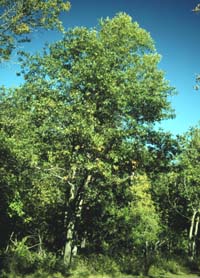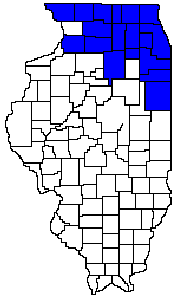 |
| Hill's
Oak (Quercus ellipsoidalis)
Distribution
Map to Right |

Hill's oak grows to a height of 60 to 75 feet, with a trunk diameter of up to 2 feet. The stubs of dead branches often persist on the trunk. The crown is rounded, with the lower branches drooping low to the ground. Hill's oak occurs on dry, sandy sites, dry upland woods, and occasionally on moderately mesic slopes or uplands. In Illinois, it is present only in the northern-most tier of the state, and often occurs with black oak.
Interesting
Facts
Hill's oak closely resembles pin oak. Some refer to it as northern pin oak, but the practice can be confusing. Hill's oak is distinguished from pin oak by its acorns, which are elongated (about twice as long as those of pin oak) and tapering to the tip. The two species differ in habitat preference as well. Hill's oak prefers drier sites whereas pin oak grows on moist bottomland soils. Hill's oak leaves turn color and are shed in the autumn, whereas those of pin oak persist into the winter.
Identifying Features
BarkUses
Hill's oak is a member of the red oak group. Its bark is gray to black or dark brown, shallowly fissured, with inner bark that is slightly orange in color.
Twigs
The twigs are dark reddish brown and slender with hairless terminal buds of the same color.
Buds
The buds are ovoid and about 1/4 inch long.
Leaves
The leaves are alternate, simple, roughly elliptic, from 3-7 inches long, and slightly tapering or straight across at the base. The leaf stalks are from 1/2 to 2 1/2 inches long. The leaves have from 2-4 pairs of deeply incised lobes (cut about 1/2 of the distance in toward the mid-rib of the leaf) with sharply pointed bristle tips. They are dark green and mostly smooth on the upper surface and lighter green and smooth underneath.
Flowers
Hill's oak is monoecious, having both male and female flowers borne separately on the same tree. The staminate (male) flowers appear as catkins, and the pistillate (female) as groups of 2 - 3, or a solitary, inconspicuous hanging flowers. Flowers emerge as the leaves unfold in the spring.
Fruits
Acorns are produced every other year. Each acorn requires two years to mature and ripens in October. They are produced on extremely short stalks, are longer than they are broad (less than 1/2 inch broad, and up to about 3/4 inch long), and are sharply pointed at the base. They are occasionally striped, smooth, and brown. The cup is reddish brown and covers from 1/3 to 1/2 of the nut.
Hill's oak wood is heavy and strong. It is used in the manufacture of shingles and for interior finishing.